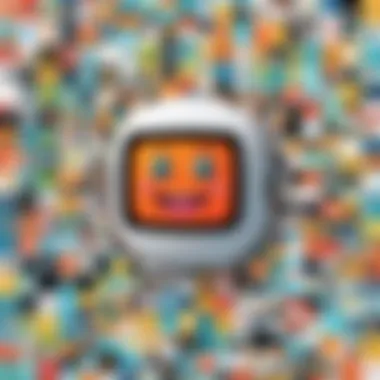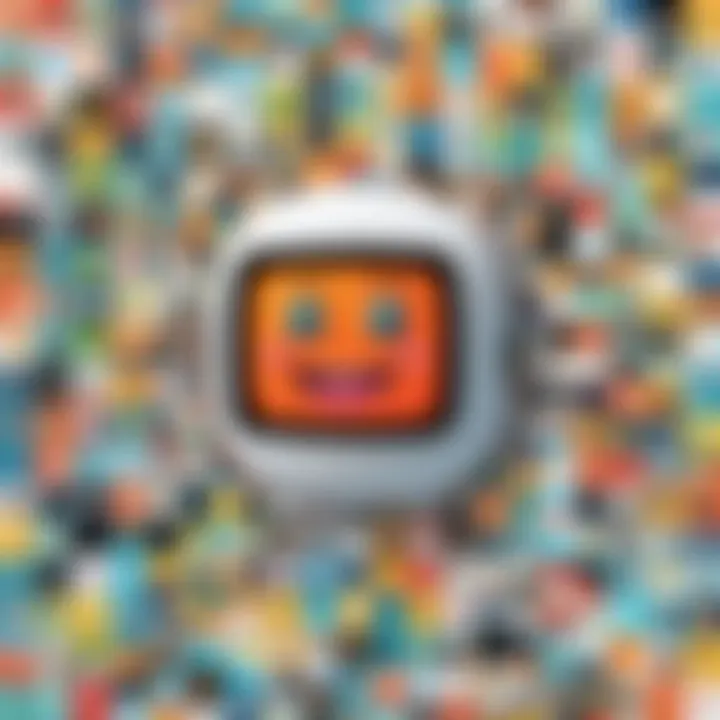Humor Meets Innovation: A Deep Dive


Intro
Humor and technology have a complex and evolving relationship. In recent years, we have witnessed this intersection continually shape our interactions and influence our society. As technology advances, new forms of humor emerge, reflecting cultural trends and collective sentiments.
This article explores various elements that highlight the ways humor and technology intertwine. By examining tech-driven humor, we will consider memes on social media, satirical applications, and other facets that bring entertainment in the digital realm. We also address the implications of this intersection on societal commentary and personal expression. The examination will unravel the various layers of funny in an increasingly digital world, offering a detailed understanding for an audience eager for knowledge.
Technology Insights
The technological landscape is constantly in motion. This part of the exploration focuses on how current trends in technology stimulate humor and creativity.
Latest Tech Trends
In the last few years, platforms like TikTok and Instagram have revolutionized how humor is shared. Short-form videos allow users to create funny content rapidly. Algorithms curate these videos, often showcasing whimsical or hilarious takes on everyday situations. As interactions shift online, these channels become vital in disseminating humor.
Innovation in Tech
Innovative technologies also foster comedic expression. Artificial Intelligence entities, such as OpenAI's GPT-3, can now generate humorous content, enabling users to produce jokes or comedic stories on demand. This ability can reshape traditional humor creation, transitioning it towards a more collaborative process between humans and machines, which can lead to unpredictable and fresh comedic formats.
Product Reviews
Devices and apps that enhance comedic experiences are in constant emergence. Take for instance the app "Super Funny Videos," which curates humorous clips from various sources. This application is designed to bring laughter into users' daily routine. Reviewing engaging apps and products will offer insights into what entertains and resonates with today's audience.
Entertainment Highlights
When examining humor, entertainment aspects deserve close scrutiny. The influence of technology on movies and music is substantial and worthy of discussion.
Movie Reviews
Films increasingly leverage comedic technology, from artificial intelligence in scriptwriting to using special effects for visual comedy. For instance, the film "Free Guy" uses gaming technology to create humor through a narrative that plays with video game tropes.
Music Releases
Musicians also incorporate humor into their work. Artists like Bo Burnham and Weird Al Yankovic blend social commentary and comedy within their songs, often utilizing digital platforms to reach audiences globally. The technology behind music production plays a role in crafting these humorous messages.
Celebrity News
With the rise of social media, celebrities now engage with their fans in light-hearted ways. For example, platforms like Twitter allow for immediate and comedic interactions between celebrities and their followers. These light-hearted exchanges highlight a growing trend of accessibility in the realm of fame.
Industry Spotlights
The tech and entertainment industries intertwine in numerous ways. Key figures within these domains help shape this relationship.
Interviews with Tech Experts
Engaging with tech experts can provide insights into how technology gears comedy creation. These discussions may reveal trends, challenges, and predictions about the humor's digital future.
Behind-the-Scenes in Entertainment
Understanding the behind-the-scenes dynamics can shine a light on how creativity flourishes in technology-heavy environments. For example, how does a team of comedians adapt to technological tools in their work?
Designers to Watch
In addition, designers working in tech can drive humor's visual aspect. Their work can bridge the gap between functionality and entertainment.
Event Coverage
Technology and entertainment jointly flourish through events that showcase innovation in humor.
Tech Conferences Report
These gatherings often feature tech-driven humor presentations. They reflect on how technology influences comedic practices today.
Entertainment Awards Show Recap


Awards shows have increasingly highlighted technology in humor, stirring conversations about its role today and in future.
Design Exhibitions Highlights
Exhibitions illuminating design also illustrate the interplay of creativity and comedy using technology, providing a unique lens through which to explore the topic.
Humor in technology is not just an escape; it is a reflective commentary on society's shifting demands and desires.
Intro to Humor in Technology
Humor and technology have a complex and dynamic relationship. This section serves to illuminate the depth of that intersection. Understanding how laughter interacts with technology is crucial for recognizing its role in daily interactions, as well as in broader societal commentary. The examination of this interplay helps us appreciate not only the forms humor can take in tech but also its influence on human connections.
Defining Humor
Humor can be hard to define due to its subjective nature. Generally, it refers to the quality of being amusing or entertaining. It involves various elements including wit, irony, or absurdity. Despite its ambiguity, humor often acts as a social glue, bringing people together and lightening conversations. In the context of technology, humor can manifest through memes, apps designed for comedic entertainment, or even clever programming jokes. It reflects and resonates with human emotions and experiences, adapting to the mediums through which it is conveyed.
The Role of Technology
Technology serves as an enabler of humor. Its advancement facilitates new platforms for comedic expression, distributing content to a wide audience almost instantly. Social media sites like Facebook and Instagram allow users to share humorous content effortlessly. Additionally, tools such as video editing software or meme generators empower individuals to create personalized comedic content. The integration of technology in comedic forms transforms traditional humor into an expansive digital landscape. It modifies the way humor is produced, consumed, and shared. This adaptability is a significant contributor to the evolution of comedic practices.
Humor as a Social Commentary
Humor often serves as a vehicle for social commentary. It can reflect cultural norms or challenge societal issues in subtle yet impactful ways. In a technologically advanced society, humor provides a lens through which people can critique the world around them. Whether through satirical articles, viral videos, or comedic podcasts, tech-driven humor often addresses topics like politics, social justice, or environmental concerns. This intersection allows for discussions that might be difficult to approach otherwise. By using humor, creators can initiate dialogue and provoke thought while entertaining, making it a powerful tool in societal discourse.
"Humor lends an air of lightness to heavy subjects, providing a unique space for both laughter and reflection."
Evolution of Comedic Technology
The evolution of comedic technology is pivotal to understanding the interaction between humor and technology. Over time, humorous expressions and content have adapted alongside technological advancements. This section will unpack the historical context of comedy, the transformative impact of the internet, and the influence of social media on how humor is created, consumed, and shared.
Historical Context
Historically, humor has been a reflection of society, with roots tracing back to ancient civilizations. In the past, storytelling and performance arts served as primary tools for sharing comedic content. People bonded over shared experiences, using humor as a means to comment on life events, social norms, and political issues. With the introduction of the printing press, comedic literature gained traction, allowing for the broader dissemination of jokes and satire.
More recently, the invention of broadcasting technologies, such as radio and television, reshaped comedic communication. Iconic shows like "Saturday Night Live" and the emergence of stand-up comedy laid the groundwork for humor adapting to new formats. This historical evolution shows how humor has continuously leveraged technology.
Impact of the Internet
The advent of the internet transformed the comedic landscape dramatically. It democratized content creation, allowing anyone with an internet connection to participate. Platforms such as YouTube, for example, provided a venue for aspiring comedians to share their talent without the traditional gatekeepers of television networks.
Furthermore, the ability to share content instantly across the globe has facilitated a new form of humor. Online communities have sprung up, where jokes can be shared and refined rapidly. This has allowed for niche humor to thrive, enabling even the smallest subcultures to find their voice. As a result, comedy has become more varied and accessible than ever before.
Social Media's Role
Social media stands as a cornerstone in the modern comedic ecosystem, fundamentally shifting how humor is produced and experienced. Platforms like Twitter, Facebook, and Instagram have birthed a new genre of humor tied to brevity and immediacy. Memes, which often consist of simple images paired with clever text, exemplify this phenomenon, allowing for rapid sharing and remixing.
The viral nature of social media means that certain comedic bits can gain traction quickly, reaching audiences far beyond local communities. Furthermore, the algorithms of these platforms often prioritize engaging content, which drives the development of humor that resonates on a mass scale. Users now engage more through laughter and irony, connecting over shared memes and responses that oftentimes parody current events or viral culture.
"Social media has made it possible for comedians to engage directly with their audience, creating a two-way dialogue that was previously absent in traditional media."
Forms of Technology-Driven Humor
Forms of technology-driven humor have fundamentally changed how people perceive and share comedy in the digital age. The integration of technology into humor not only reflects society's values but also offers a unique platform for voices that were previously marginalized. The rapid evolution of technology has generated countless opportunities for creativity and innovation in humor. This section will examine some key forms of humor that thrive in a tech-centric landscape, their significance, and how they shape societal interactions.
Memes and Virality
Memes represent one of the most significant forms of technology-driven humor. They are succinct, shareable snippets of humor that often rely on images or videos accompanied by text. Memes serve as conduits of cultural commentary and social insight, reflecting trends and attitudes in real time. The virality of memes highlights their ability to transcend geographical barriers, allowing a humorous idea to spread rapidly across the globe.
Memes can convey complex emotions and ideas succinctly, making them easily digestible. Their concise nature appeals to users' shorter attention spans, a characteristic of the digital age. The constant churn of memes creates a dynamic landscape in which humor evolves quickly, driven by the audience's reaction and engagement.
Prominent platforms like Reddit and Facebook amplify this phenomenon. On these networks, users share and remix memes across communities, establishing a participatory culture. However, it's essential to understand the implications of meme culture, particularly regarding misinformation and social commentary.
Satirical Applications
Satire, as a form of humor, has found fertile ground in the realm of technology. Various channels now enable the dissemination of satirical content, including dedicated websites and social media accounts that focus solely on tech critiques. Satirical applications use humor to challenge societal norms and critque corporatism or governmental policies.


Shows like Saturday Night Live often feature sketches that satirize current tech events or public figures within the industry. This form of technology-driven humor provides audiences with a humorous lens through which to view complex issues, offering not just entertainment but also critical commentary.
The accessibility of tools to create satire extends beyond professional comedians. Anyone with basic digital skills can produce and share satirical content, leading to an explosion of perspectives and voices in the discourse around technology. While the humor may often be biting, it plays a fundamental role in encouraging society to reflect on its values and actions.
Stand-Up in the Digital Age
Stand-up comedy has also undergone a transformation with the advancement of technology. Comedians now utilize platforms like YouTube and TikTok to reach wider audiences. This democratization allows for diverse voices to emerge, challenging traditional comedy norms. Stand-up routines can be streamed live or recorded, making them accessible to viewers worldwide.
The cultural landscape significantly influences the content of stand-up routines. Comedians leverage current events, technology trends, and social issues, making their routines timely and relevant. The immediacy of sharing these acts via social media facilitates discussion, and often, audiences engage with the content in real-time.
Additionally, the feedback loop created by social media allows comedians to refine their material based on audience reactions. This interactivity enriches the comedic process and creates a unique form of collaboration. While stand-up comedy inherently thrives on timing and delivery, the digital age adds layers of complexity and vigor that enhance the art form.
"Tech-driven humor represents not just entertainment, but a form of societal reflection that evolves with each passing trend."
In sum, the forms of technology-driven humor explored here reveal a robust interplay between comedy and the digital landscape. Memes, satire, and stand-up comedy have all adapted to the technological advancements of our time, illustrating how humor can reflect, critique, and engage a tech-savvy audience. This transformation in humor offers significant insights into contemporary culture, as it continues to evolve alongside technology.
Psychology of Humor in Tech
Understanding the psychology of humor in technology is essential for analyzing how comedy interacts with digital platforms. Humor acts as a social lubricant and a communication tool. Its role extends beyond mere entertainment, influencing how people engage with technology and each other. Technological advancements shape the way humor is created and shared. Therefore, exploring the psychological underpinnings of humor allows us to appreciate its significance in this sphere.
Cognitive Processing of Humor
Cognitive processing of humor involves how individuals perceive, interpret, and respond to comedic content. Humor can often challenge cognitive norms, inviting users to think differently. For example, jokes about tech failures or glitches can resonate well with audiences who have encountered similar issues. The benign violation theory explains that humor often stems from juxtaposing acceptable and unacceptable scenarios in a way that provokes laughter without inciting offense. This balance is critical, especially in tech-related humor where sensitivities around topics like data breaches or privacy invasions can be high.
The processing of humor entails several cognitive functions, including:
- Recognition of incongruity: Users must identify what makes a situation funny.
- Emotional response: This includes laughter or amusement, which leads to further engagement.
- Social bonding: Shared humor can foster connections among users, enhancing community feelings.
Cultural Influences on Humor
Cultural context heavily influences what is perceived as humorous in relation to technology. Different cultures have unique comedic forms, values, and sensitivities. For instance, a meme that resonates in the United States may fail in Japan due to differing societal norms. Moreover, cultural references play a crucial role in shaping humor. Digital platforms enable cross-cultural exchanges, but this can also lead to misunderstandings or the misinterpretation of humor.
Considerations of culture in tech humor include:
- Cultural relativity: Humor that works in one culture may not translate well to another.
- Language barriers: Puns or wordplay often do not carry over between languages effectively.
- Local trends: Each community possesses its comedic trends, directly influenced by local events, celebrities, and societal changes.
The Role of Timing and Context
Timing and context are vital elements for humor to be effective. In the digital age, the pace at which information spreads can determine the success of humorous content. For example, a meme can become viral if it taps into current events or trending topics. The immediacy of social media allows tech humor to evolve quickly, but it also requires creators to remain relevant and sensitive to ongoing discussions.
Key aspects of timing and context in humor include:
- Real-time relevance: Humor must relate to current events or ongoing discourse to resonate well.
- User familiarity: Audiences need to understand the context behind the humor for it to be effective.
- Platform specifics: Different social media platforms have unique cultures and timing rules, affecting how humor is received.
Humor is not just about making people laugh; it's also a reflection of the cultural and social environment in which it is created.
Revisiting these elements establishes a framework for how technology shapes and is shaped by humor. As technology continues to evolve, understanding these psychological factors becomes increasingly relevant.
Case Studies in Technology Humor
Analyzing case studies within the realm of technology humor is essential for understanding how humor evolves with advances in tech. Each case provides insights into the styles and methods that resonate with audiences. Successful examples enrich this landscape, showing the connection between creativity, innovation, and cultural context. Through these studies, we can see how humor can reflect societal perspectives and make technology more relatable.
Successful Tech Comedies
Modern tech comedies often encapsulate the absurdities of life in a digital world. Shows like Silicon Valley and The IT Crowd showcase the quirks of tech culture. They entertain while providing sharp social commentary. These series highlight how developers and tech entrepreneurs navigate both their professional lives and personal struggles.
The humor lies in exaggeration, and the characters often find themselves in ridiculous situations that resonate with many working in the industry. This reflects real frustrations in tech, thus deepening the audience's connection.
"Tech comedies are not just entertainment; they give insight into the culture and chaos behind innovation."
The Rise of Tech TikTok Creators
TikTok has revolutionized how humor is created and consumed, particularly in the tech sphere. Creators such as @the.tech.guy and @techwithtim focus on short, clever videos that play with technology concepts, trends, and gadgets. Often, they blend humor with educational content, making complex topics accessible and engaging. Many creators explore trends surrounding new devices, offering comedic reviews that attract large audiences. This format allows for quick consumption while promoting tech products.


Analysis of Popular Parody Accounts
Parody accounts on platforms like Twitter and Instagram tackle contemporary tech issues through humor. Accounts such as @TechHumor and @TheCodeWizard promote amusing takes on coding failures, tech support requests, and the often chaotic nature of the tech industry.
These parodies rely on shared experiences among tech workers, enhancing relatability. They often highlight the silliness found within the jargon-ridden culture of programming and tech development. This not only entertains but also creates a community among professionals who engage with this humor, providing collective validation for their everyday frustrations.
In summary, case studies in technology humor reveal a vibrant interaction between laughs and digital experiences. Successful tech comedies, impactful TikTok creators, and iconic parody accounts form a rich tapestry of humor that thrives on the nuances of technology. Understanding these elements offers a deeper appreciation of the comedic landscape influenced by technology.
Implications of Humor in Technology
Understanding the implications of humor in technology is crucial for both creators and users within the digital landscape. As technology evolves, so does the way humor is expressed and perceived. This section explores specific aspects including influence on user behavior, marketing strategies, and the integration of comedy into user interfaces. Each element reveals deeper insights into how humor shapes our interactions with technology.
Influence on User Behavior
Humor influences user behavior significantly. It can enhance user engagement, foster community, and facilitate information retention. When users find content amusing, they are more likely to share it, thereby increasing its reach. For instance, memes often spread virally through platforms like Facebook and Reddit, primarily because they resonate emotionally with users.
Moreover, humor can make technology feel less intimidating. A well-placed joke or playful design can break down barriers of complexity and enhance user comfort. This approach can lead to increased usage and a greater willingness to explore new features.
In some cases, humor can also serve as feedback. Users may respond differently to interface design that incorporates comedic elements compared to a more serious approach. For example, a quirky error message can lighten the frustration of a technical issue.
Humor as a Marketing Tool
Incorporating humor into marketing strategies can yield impressive results. Brands like Old Spice and Dollar Shave Club have effectively utilized comedic advertising to capture attention and create memorable impressions. By leveraging humor, these brands not only convey their messages but also position themselves as relatable and approachable.
Social media platforms amplify this effect. Funny content is more likely to be shared, increasing organic reach without substantial additional costs. The potential for virality illustrates why companies invest in creatives who can produce humor-driven content.
Furthermore, understanding the audience's sense of humor is essential. What one group finds amusing, another may disregard. Marketers must carefully match their comedic approach to the demographic they are targeting.
Comedic Techniques in User Interfaces
User interfaces can benefit from incorporating comedic techniques. Simple additions, such as playful language or whimsical graphics, can enhance the user experience. For example, apps often use lighthearted messages to guide users through processes, alleviating moments of confusion or error.
Consider the use of animated characters or quirky icons that respond to user actions. These elements not only entertain but can also communicate information in a more digestible manner. Users may find such interfaces more intuitive, leading to improved satisfaction and loyalty.
The Future of Technology and Humor
The intertwining of humor and technology is an evolving narrative. The future of technology and humor probes the dynamic growth of digital innovation and its influence on comedic forms. This connection is significant as it shapes not only entertainment but also cultural discourse. As humor adapts with technological advancements, it raises questions about its essence and impact in society.
Emerging Trends and Technologies
A diverse range of trends and technologies are emerging that reshape how humor is created and consumed. Virtual reality (VR) and augmented reality (AR) are paving the path for immersive comedic experiences. These technologies offer creators the chance to merge environments with comedy, making interactions more engaging.
Artificial intelligence is another frontier. AIs, such as those developed by OpenAI or Google, can generate jokes, memes, or satirical content. This incorporation of AI raises fascinating possibilities, as the algorithm’s capability to analyze user behavior allows tailored humor to each individual. This customization could lead to a deeper humor experience that resonates with users on a personal level.
Social media platforms continue to evolve, introducing new formats that can amplify humorous content. TikTok, for instance, stands out with its short video format that encourages creativity in comedic storytelling. With the rise of deepfake technology, the potential for creating humorous content will also increase, albeit with concerns about misleading visuals.
Potential Ethical Concerns
The integration of humor and technology is not free from ethical dilemmas. The use of AI in generating humor brings forth questions of originality and authorship. If a machine creates a joke or meme, who owns it? This uncertainty can blur the lines between creativity and automation. Additionally, there is a risk where humor can be weaponized. Deepfake technology can create comedic content, but can also lead to malicious alterations, undermining trust in media.
Another concern relates to the societal impact of humor that is amplified through algorithms. Humorous content that relies on stereotypes can perpetuate harmful biases. Understanding these dynamics is critical to navigate the future landscape responsibly.
"As technology advances, the essence of humor may shift, requiring us to reevaluate what constitutes comedy in our digital world."
Predictions for Content Creators
Content creators must adapt to the changes in both technology and humor. As audiences become more discerning, the demand for authenticity will grow. Comedians and humorists will likely focus more on crafting genuine narratives that resonate with audiences rather than relying solely on novelty.
Moreover, collaborations between technologists and humorists may become more common. Marrying humor with tech innovation could result in unique content that captures the zeitgeist. Those who navigate these changes with agility may find new opportunities for engagement and storytelling.
Furthermore, understanding platform algorithms will be essential. Creators will need to understand how various platforms promote content and find ways to stand out in increasingly crowded spaces.
Finale: Reflecting on Technology and Humor
The relationship between technology and humor is complex and multifaceted. Understanding this intersection allows us to appreciate not just what makes us laugh but also why it resonates in a digital landscape. In this article, we have explored various dimensions of humor influenced by technology. The study of humor in tech aids in grasping cultural trends and user behaviors in contemporary media. As technology continues to evolve, so do the forms of humor, and recognizing this evolution provides insights into societal shifts and the collective psyche.
Summarizing Key Points
Throughout this exploration, several key points emerge:
- Humor as a Reflection of Society: Technology serves as a mirror, reflecting societal values and norms through comedic expressions.
- Impact of Social Media: Platforms like TikTok and Instagram have democratized humor, enabling anyone to create and share comedic content widely.
- Psychological Insights: Understanding cognitive processes behind humor enhances our comprehension of why certain jokes or memes appeal more than others.
- Implications in Marketing: Brands increasingly leverage humor in advertising strategies, recognizing its effectiveness in engaging audiences.
- Emerging Tech Influences: The continuous innovation in technology shapes new comedic formats and requires an adaptation of humor styles.







